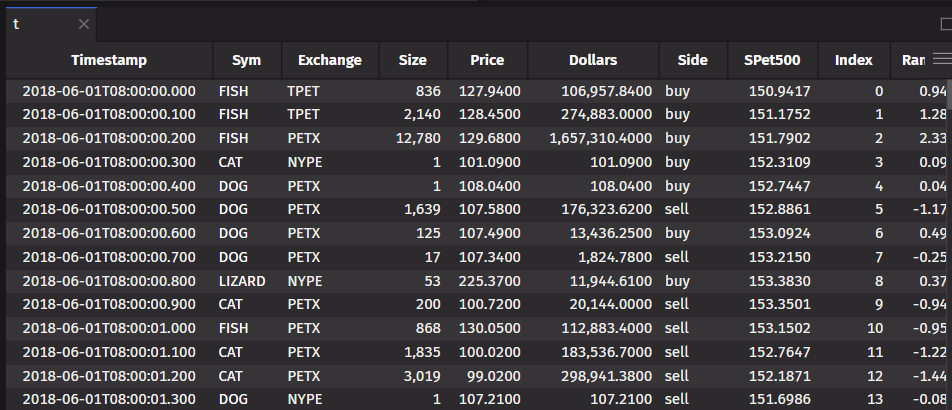Work with Tables
The Deephaven table is the key abstraction that unites static and real-time data for a seamless, integrated experience. Combining tables with deephaven.ui components allows you to create your own powerful, data centered workflows.
For more information, see Working with Deephaven Tables.
Display a table in a component
You can display a Deephaven table in a component by doing one of the following:
- return a table directly from a component
- return a table as part of a
listortuple - add a table to a container such as a
flexorpanel - use ui.table
from deephaven import new_table, ui
from deephaven.column import int_col
# Prepend name with an underscore to avoid displaying the source table
_source = new_table([int_col("IntegerColumn", [1, 2, 3])])
@ui.component
def single_table(t):
ui.use_effect(lambda: print("displaying table"), [])
return t
@ui.component
def list_table(t):
return [ui.text("list table"), t]
@ui.component
def flex_table(t):
return ui.flex(ui.text("flex table"), t)
my_single_table = single_table(_source)
my_list_table = list_table(_source)
my_flex_table = flex_table(_source)

Use ui.table
ui.table is a wrapper for Deephaven tables that allows you to change how the table is displayed in the UI and how to handle user events. Here is an example of adding custom color formatting.
from deephaven import ui
import deephaven.plot.express as dx
_stocks_table = dx.data.stocks()
t = ui.table(
_stocks_table,
format_=[
ui.TableFormat(color="fg"),
ui.TableFormat(cols="Sym", color="white"),
],
)

Memoize table operations
If you are working with a table, memoize the table operation. This stores the result in a memoized value and prevents the table from being re-computed on every render. This can be done with the use_memo hook.
from deephaven import time_table, ui
from deephaven.table import Table
theme_options = ["accent-200", "red-200", "green-200"]
@ui.component
def ui_memo_table_app():
n, set_n = ui.use_state(1)
theme, set_theme = ui.use_state(theme_options[0])
# ✅ Memoize the table operation, only recompute when the dependency `n` changes
result_table = ui.use_memo(
lambda: time_table("PT1s").update(f"x=i*{n}").reverse(), [n]
)
return ui.view(
ui.flex(
ui.picker(
*theme_options, label="Theme", selected_key=theme, on_change=set_theme
),
ui.slider(value=n, min_value=1, max_value=999, on_change=set_n, label="n"),
result_table,
direction="column",
height="100%",
),
background_color=theme,
align_self="stretch",
flex_grow=1,
)
memo_table_app = ui_memo_table_app()
Hooks for tables
The use_table_data hook lets you use a table’s data. This is useful when you want to listen to an updating table and use the data in your component.
from deephaven import time_table, ui
@ui.component
def ui_table_data(table):
table_data = ui.use_table_data(table)
return ui.heading(f"The table data is {table_data}")
table_data = ui_table_data(time_table("PT1s").update("x=i").tail(5))
The use_cell_data hook lets you use the cell data of the first cell (first row in the first column) in a table. This is useful when you want to listen to an updating table and use the data in your component.
from deephaven import time_table, ui
@ui.component
def ui_table_first_cell(table):
cell_value = ui.use_cell_data(table)
return ui.heading(f"The first cell value is {cell_value}")
table_first_cell = ui_table_first_cell(time_table("PT1s").tail(1))